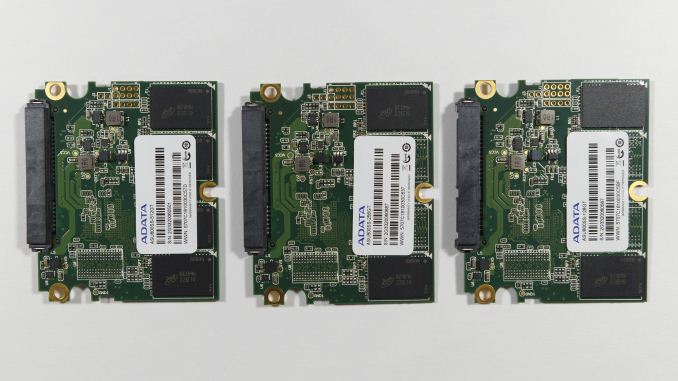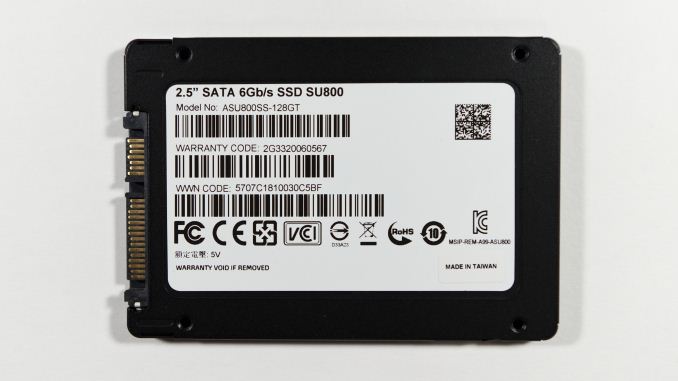The ADATA Ultimate SU800 SSD Review (128GB, 256GB, 512GB)
by Billy Tallis on February 1, 2017 12:01 PM ESTFinal Words
Judged against other entry-level SATA SSD, the ADATA Ultimate SU800 does not offer many significant performance improvements from its use of Micron 3D TLC NAND. Even if Micron's 3D TLC were substantially faster than the planar TLC it is competing against, the capacity of 384Gb per die compared to 128Gb for the planar TLC means that the SU800 has to get by with far fewer NAND chips to stripe accesses across. This parallelism is very important to achieving high performance, but the smallest 128GB SU800 has only three NAND flash chips to work with.
As total NAND capacity per die has increased, the page and erase block sizes have increased also. This is likely a major contributor to garbage collection having a much larger performance impact on the SU800 and Crucial MX300 than earlier TLC drives. Silicon Motion's controller and firmware in the ADATA SU800 don't seem to have adjusted to this quite as well as Micron's firmware has for the Marvell controller in the Crucial MX300. Despite having more spare area due to offering less usable capacity from the same amount of NAND, the 512GB ADATA SU800 seldom outperforms the 525GB MX300.
With the Crucial MX300, Micron chose to offer capacities of 275GB and up, retiring the 128GB capacity class. They also chose not to sample us the 275GB MX300, likely because of its lower performance than the larger capacities. ADATA is emphasizing those smaller capacities with the SU800 and taking on the challenge of offering decent performance with less parallelism available.
For light workloads where SLC caching is highly effective, ADATA has succeeded in roughly matching the performance of the last generation of planar TLC budget SSDs. This has come at the apparent expense of performance on heavier workloads and when working with a full drive. The 512GB SU800 is the smallest capacity that performs well on our ATSB Heavy test, and at all capacities it is important to not let the SU800 fill up or operate without TRIM being used.
Back when most of the SSD market was still using MLC NAND, Silicon Motion established a reputation for offering one of the most power efficient platforms. This advantage has been reduced with the transition to TLC for mainstream drives, and with the SU800 it now seems to be completely gone. In terms of power consumption, the SU800 and every other budget and mainstream SSD are still overshadowed by the Crucial MX300's remarkable efficiency.
| 120-128GB | 240-275GB | 480-525GB | 960-1050GB | |
| ADATA SU800 | $52.99 (41¢/GB) | $81.99 (32¢/GB) | $147.07 (29¢/GB) | $269.99 (26¢/GB) |
| ADATA SP550 | $48.99 (41¢/GB) | $71.97 (30¢/GB) | $134.99 (28¢/GB) | $299.99 (31¢/GB) |
| PNY CS1311 | $49.99 (42¢/GB) | $59.99 (25¢/GB) | $129.99 (27¢/GB) | $269.99 (28¢/GB) |
| Samsung 750 EVO | $85.98 (72¢/GB) | $129.95 (52¢/GB) | $139.99 (28¢/GB) | |
| Samsung 850 EVO | $98.00 (39¢/GB) | $169.99 (34¢/GB) | $319.99 (32¢/GB) | |
| Crucial MX300 | $89.99 (33¢/GB) | $146.42 (28¢/GB) | $259.99 (25¢/GB) |
The ADATA SU800 is priced as an entry-level SSD, but the entire market is heavily affected by an ongoing NAND shortage. There are a few older planar TLC SSDs that are still able to beat the SU800's prices by a few dollars, when they're in stock. But the bigger problem for the SU800 is that ADATA can't reliably beat Micron's pricing on the Crucial MX300. When taking into account the slightly higher usable capacity and better performance and efficiency, the MX300 is a better deal than the equivalent SU800.
That leaves the 128GB SU800 as the only member of the lineup that might make sense to buy at the moment. It has far fewer competitors as 120GB SSDs are disappearing from the market. With the caveat that the 128GB SU800 should only be used in scenarios where it is definitely larger than necessary and will be presented with light workloads, the SU800 is a fine alternative and a reasonable purchase if it's roughly tied for being the cheapest SSD in that capacity class.
Related SATA SSD Reading:












35 Comments
View All Comments
SaolDan - Wednesday, February 1, 2017 - link
Neat!!!MrSpadge - Wednesday, February 1, 2017 - link
Overall a worse deal than the MX300, which itself took quite some criticism. Could you elaborate on what's "neat" about this?vladx - Wednesday, February 1, 2017 - link
Price is low for decent performance. This is SATA SSD targeted towards low end and mainstream market.Great_Scott - Wednesday, February 1, 2017 - link
The MX300 is better value given the drive sizes. I'm still trying to find a replacement for the Mushkin Reactor for desktops, but the Crucial drive is my go-to for laptops currently.Arbie - Wednesday, February 1, 2017 - link
Why do you guys continually fail to mention the Mushkin Reactor 1TB MLC drive ($240 at Newegg) in your SSD comparisons? It's cheaper, faster, and probably has greater endurance.You reviewed it two years ago but have hardly mentioned it since then. It seems to be a "best buy" still.
http://www.anandtech.com/show/8949/mushkin-reactor...
But... kudos on the clickbait. You have at least as much as any other site, and of the lowest degree.
vladx - Wednesday, February 1, 2017 - link
Because Mushkin already refreshed their SSD line and the old Reactor is not manufactured anymore which means it will be gone any week now.Great_Scott - Wednesday, February 1, 2017 - link
And we will all be sad to see it go. I have a bunch of those drives, myself.Flunk - Wednesday, February 1, 2017 - link
They don't often put 2 year old drives in comparisons.Great_Scott - Wednesday, February 1, 2017 - link
That's too bad, as some context would be useful, especially considering that many people own that drive, and until recently it was still being made.Then again, a two-year-old budget drive with a very similar controller would have made the SU800 series look terrible, and we can't have that.
eek2121 - Wednesday, February 1, 2017 - link
The Mushkin Reactor is a drastically slower drive, costs about the same, and will soon disappear from retailers. It is not a competitor.